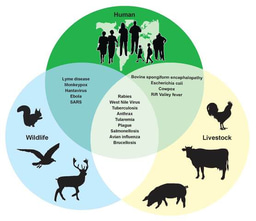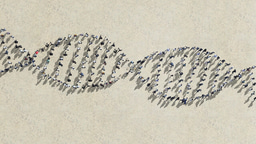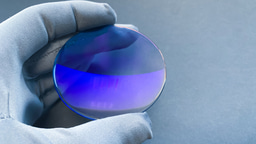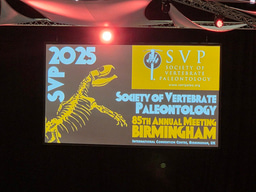1. What made you want to be a biochemist?
I grew up in Chengdu, China. When I was about 7 years old, I was often very curious about how my pet silkworm made silk from only eating mulberry tree leaves! Why cannot we do the same? The leaves are from plants, which are mostly made of cellulose or sugar units, but the silkworm silk is protein, made of amino acids! When I was about 9, I had a white hen as a pet. I was often wondering how the hen could eat rice and other things, but lay an egg every day! An egg has a hard shell that encloses the egg white and yellow yolk. I could not understand how the white hen could do that at all.
Unfortunately, the chaotic Culture Revolution went into full swing when I was only 13 and I lost the chance to go to junior high and high school because they were all closed for several years. But fortunately, in 1976, I was able to go to college to pursue my interest through a fortuitous opportunity to study biochemistry. Once there, I tried to recover the time I had lost and pursued biochemistry enthusiastically with all my effort. There were no textbooks at all and we had to take our notes from lectures – I had never heard of the great biochemistry textbooks by leading biochemists such as Albert Lehninger, Lubert Stryer and Geoffrey Zubay. I never heard of Nature nor Science magazines. However, my thirst for learning was so great, I overcame many obstacles and finished my biochemistry B.S. degree in China.
2. If you weren’t a biochemist and could do any other job, what would it be – and why?
I would probably become a marine biologist, studying the fantastic oceans around the world. The oceans are the most fascinating places on the planet. There are so many extraordinary, alien-like, otherworldly, unimaginable and amazing creatures that live right under our nose, but we know virtually nothing about their biochemistry and physiology. For example, how can some creatures survive under several thousand meters of water on the deep sea floor, where no steel submarine can go? How can they see in the utter darkness? How fast do they reproduce and how does their DNA replicate? How can they change color so quickly to capture prey or to avoid predators? What are the colors made of? Do their proteins function like ours? The oceans are full of under-explored treasures. Currently, green fluorescent protein (GFP) from jellyfish and red fluorescent protein from coral have been enormously useful for biology, biotechnology and neuroscience. But they are only two out of trillions or zillions of treasures we know nothing about. Studying creatures in the oceans would be a great lifetime pursuit.
3. How can chemists best contribute to the world at large?
Chemists can make big contributions, particularly by making new materials for collecting the practically inexhaustible supply of solar energy, biosolar energy and other truly renewable energy sources. Chemists must do to a lot more to find solutions to combat the undeniable effect of global warming. It is our responsibility. All other activities, including making new drugs are much less important than finding an alternative source of clean and renewable energy, since all our activities depend on cheap energy. Imagine if the energy cost goes up, everything will quickly follow. Sadly, most chemists have not done enough at all in pursuing new energy research. Most big oil companies have made so much money in recent years, but little has been reinvested to solve the looming big problem, except for BP, who have invested a substantial amount of revenue for new energy research. Without solving the energy and global warming problems, which are tightly coupled, everything else will become insignificant.
4. Which historical figure would you most like to have dinner with – and why?
I would like to have dinner with Wolfgang Amadeus Mozart and Ludwig Beethoven and other great classical music composers. They not only truly captured pure human spirit and life experience, but also distilled the best culture that will resonate universally forever. Their music has been played for a few hundred years and will likely be played for thousands more years. Mozart often composed his elegant and timeless music at the last minute, a true music composer genius! Sadly, much of the current music songs are likely short-lived, trendy and fashionable. Few trendy music songs will be played 100 years from now. Unfortunately, some of today’s science activities are also like the current music, very trendy and fashionable.
5. When was the last time you did an experiment in the lab – and what was it?
The last time I did experiments, was to try to grow membrane protein crystals in February 2007 in the Department of Biochemistry at the University of Cambridge, UK when I was on my academic sabbatical with a Guggenheim Fellowship. Membrane proteins are one of the most difficult protein classes to work with. For example, as of April 2007, there are about 40,000 protein structures deposited in the Protein Data Bank, but there are only a total of 250 membrane protein structures, with only 124 unique structures. That is an enormous disparity! If you look at the chemical and biological sciences as a whole, very few people work on these elusive protein structures because they are very difficult to deal with. Yet, they are the best nature-made nanomaterials and nanodevices, from harvesting clean energy to ultrasensitive sensing devices. Membrane proteins comprise a very large number of our total proteins, ~30% of genes in organisms sequenced so far code for membrane proteins, namely, ~8,000-10,000 human genes code for membrane proteins. Embarrassingly, only 2 human membrane protein structures are known.
6. If exiled on a desert island, what one book and one CD would you take with you?
The one book I would like to take with me is ‘Atlas of the Human Brain’. I have always been curious to read it, but never find time to do so. I am curious to know how such an unusual organ, only a few kilograms in weight, can not only organize memory, produce thoughts and images and detect smells, but also produce emotions and feelings. The only CD I would like to take is one featuring Mozart’s piano concertos. The only DVD I would take is ‘From Russia with Love’ with Sean Connery as the best 007 Bond – James Bond, a timeless fun movie full of various cultures, humor, fun, excitement, exotic places and beauty.
Shuguang Zhang is in the Center for Biomedical Engineering at the Massachusetts Institute of Technology, Cambridge, MA and has invented several self-assembling peptide systems, including 1) lipid-like peptide surfactants that not only form nanotubes and nanovesicles, but also stabilize diverse membrane proteins, 2) designer Lego-like peptides that form nanofiber scaffolds for 3D cell culture and regenerative medicine, and 3) designer active peptide inks that can be printed on surfaces to produce biologically active surfaces.





Please sign in or register for FREE
If you are a registered user on Research Communities by Springer Nature, please sign in